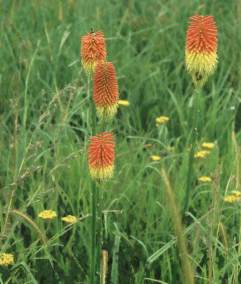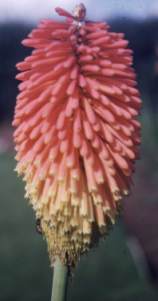Kniphofia linearifolia
Kniphofia linearifolia Baker
Family: Asphodelaceae
Common names: common marsh poker (Eng.); vuurpyl (Afr.); Icacane, Umathunga (Zulu)
Introduction
This is an attractive plant, with showy greenish yellow to yellow flowers and long, narrow leaves. It is suited to temperate gardens where it forms a strong contrast to small- or round-leaved plants.

Description
Description

The common marsh poker is a robust perennial which grows up to 1.5 m in height and is often found growing in groups. The leaves are soft and basal, yellow to dull green, and are strongly keeled with finely toothed or smooth margins. Poker-shaped flowerheads are borne on tall stalks from midsummer to autumn. Initially pinkish red to green flower buds appear, which are then followed by the greenish yellow to yellow flowers. They are neatly arranged in a dense inflorescence. From a distance the floral arrangement may be mistaken for that of a grassland aloe. Flowers are followed by greenish capsules, which contain green seeds that turn black as they mature.
Distribution and habitat
Distribution description
This is a widespread species in southern Africa occurring in Eastern Cape, Free State, KwaZulu-Natal, Swaziland, Mpumalanga and Zimbabwe, with an outlier recorded at Worcester in Western Cape. It occurs at higher altitudes, from about 300 m upwards. It is found naturally in marshy areas, streambanks and mountainous grassland.
Derivation of name and historical aspects
History
The genus Kniphofia was named in honour of Johannes Hieronymus Kniphof, (1704-1763), who was a professor of medicine at Erfurt University in Germany. There are approximately 70 species in Africa and of these, 47 occur in the eastern parts of South Africa. This includes Eastern Cape, KwaZulu-Natal, Mpumalanga, Limpopo and Gauteng and Zimbabwe. The specific name linearifolia is a Latin word meaning narrow leaves.
Kniphofia belongs to the Asphodelaceae family, which was formerly part of the Liliaceae family. The family is cosmopolitan. It is found in Europe, Asia and Africa, but mostly it is centred in South Africa, with the genera Aloe (according to some taxonomists) and Kniphofia being the main representatives. There are 17 genera in total, with 750 species; and of these, 10 genera are found in South Africa alone. The family is made up of mostly herbs, with some woody plants, such as the tree aloes. The family is characterized by bearing capsules.
There are three species within the genus that may be confused with the species linearifolia, namely. K. uvaria, K. bruceae, and K. tysonii. K. uvaria is characterized by hard leaves that are fibrous and narrow. The inflorescence is also more rounded. K. bruceae has protruding stamens with long bracts that have pointed tips. K. tysonii grows up to 2 m, and is only found in grassland. Its leaves are erect, then folding at the middle. The flower buds are orange to dull dark red. The flowers are smaller and yellow to greenish with protruding stamens.
Ecology
Ecology
K. linearifolia attracts nectar-feeding birds such as sunbirds and sugarbirds. Certain insects also visit it.
Uses
Use
Although no medicinal purposes for this species have been recorded, the flowers of some species are reportedly used as a minor food and apparently taste like honey. K. parviflora, was used as a traditional snake repellent; K. rooperii and K. laxiflora are used traditionally as a medicine.
Growing Kniphofia linearifolia
Grow
K. linearifolia grows well in rich soil in an open, sunny position or partial shade. It may be grown from seeds, which may take up to six weeks to germinate. Seeds may be sown in trays at anytime from spring to autumn. The seedlings may then be planted into the garden when they are 5-6 months old or 150 mm high and should be kept moist at all times.
The marsh poker can also be propagated from dividing large clumps, which spread by means of rhizomes. They may be lifted from the soil and divided with a sharp spade. Plant them in a well-composted growing mix (in a pot or straight into the ground) and water well. They should be kept moist until they are well established. The younger rhizomes respond well to division, whereas the older ones might struggle a bit, but can establish themselves.
Kniphofia linearifolia makes a brilliant display in a garden and the flowers last for a long time. The showy, bright-coloured flowers are ideal for adding a splash of colour to an area or making a bold statement. This plant can be used at the back of a mixed flower border, in groups in the front of a shrub border, or lining a long driveway. Flowers of this species also make excellent cut flowers.
References
- CODD, L. E. 1968. The South African species of Kniphofia. Bothalia 9: 363-513.
- JOFFE, P. 1993. The gardener's guide to South African plants. Tafelberg, Cape Town.
- POOLEY, E. 1998. A field guide to wild flowers of KwaZulu-Natal and the eastern region. Natal Flora Publications Trust, Pietermaritzburg.
- TRENDLER, R. & HES, L. 1994. Attracting birds to your garden in southern Africa. Struik, Cape Town.
- VAN DER SPUY, U. 1971. Wild flowers of South Africa for the garden. Hugh Keartland Publishers, Johannesburg.
Credits
Mhlonishwa D. Dlamini
Walter Sisulu National Botanical Garden
With additions by Yvonne Reynolds
December 2003
Plant Attributes:
Plant Type: Bulb
SA Distribution: Eastern Cape, Free State, KwaZulu-Natal, Mpumalanga, Northern Cape, Western Cape
Soil type: Loam
Flowering season: Late Summer, Autumn
PH: Acid, Neutral
Flower colour: Yellow, Orange
Aspect: Full Sun
Gardening skill: Easy
Special Features:
Horticultural zones











Rate this article
Article well written and informative
Rate this plant
Is this an interesting plant?
Login to add your Comment
Back to topNot registered yet? Click here to register.